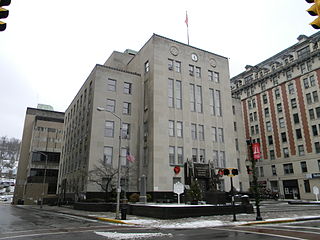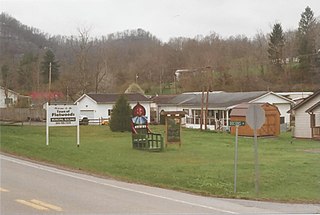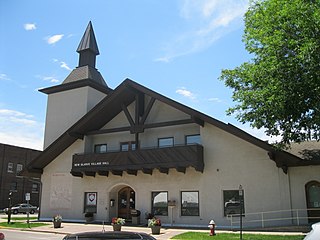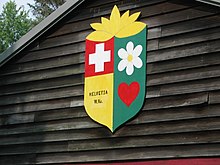
Washington County is one of 36 counties in the U.S. state of Oregon and part of the Portland metropolitan area. The 2020 census recorded the population as 600,372, making it the second most populous county in the state and most populous "Washington County" in the United States. Hillsboro is the county seat and largest city, while other major cities include Beaverton, Tigard, Cornelius, Banks, Gaston, Sherwood, North Plains, and Forest Grove, the county's oldest city. Originally named Twality when created in 1843, the Oregon Territorial Legislature renamed it for the nation's first president in 1849 and included the entire northwest corner of Oregon before new counties were created in 1854. The Tualatin River and its drainage basin lie almost entirely within the county, which shares its boundaries with the Tualatin Valley. It is bordered on the west and north by the Northern Oregon Coast Range, on the south by the Chehalem Mountains, and on the north and east by the Tualatin Mountains, or West Hills.

Sutter County is a county located in the U.S. state of California. As of the 2020 census, the population was 99,633. The county seat is Yuba City. Sutter County is included in the Yuba City, CA Metropolitan Statistical Area as well as the Sacramento-Roseville, CA Combined Statistical Area. The county is located along the Sacramento River in the Sacramento Valley.

Harrison County is a county in the U.S. state of West Virginia. As of the 2020 census, the population was 65,921. Its county seat is Clarksburg.

Doddridge County is a county in the U.S. state of West Virginia. As of the 2020 census, the population was 7,808. Its county seat is West Union.

Tell City is a city in Troy Township, Perry County, in the U.S. state of Indiana. It is located along the Ohio River. The population was 7,506 at the 2020 census. The city is the county seat of Perry County.

Mount Gretna is a borough in Lebanon County, Pennsylvania, United States. It is part of the Lebanon, PA, Metropolitan statistical area. The population was 188 at the 2020 census. The borough was founded by the Pennsylvania Chautauqua Society, which was attracted by the area's natural landscape and beauty, by the 1890s.

West Point is an incorporated town in King William County, Virginia, United States. The population was 3,414 at the 2020 census.

White Stone is a town in Lancaster County, Virginia, United States. The population was 380 at the 2020 census. White Stone is one of many small towns located in Virginia's Northern Neck region.

Flatwoods is a town in Braxton County, West Virginia, United States, located approximately one mile from exit 67 of Interstate 79.

Anmoore is a town in Harrison County, West Virginia, United States. It is located at the intersection of WV 58 and Interstate 79. The population was 514 at the 2020 census.

Clarksburg is a city in and the county seat of Harrison County, West Virginia, United States, in the north-central region of the state. The population of the city was 16,039 at the 2020 census, making it the tenth-largest city in West Virginia. It is the principal city of the Clarksburg micropolitan area, which had a population of 90,434 in 2020. Clarksburg was named National Small City of the Year in 2011 by the National League of Cities.

Nutter Fort is a town in Harrison County, West Virginia, United States, incorporated in 1923. The town is a southeastern suburb of Clarksburg.

Ridgeley is a town in Mineral County, West Virginia, United States, and part of the Cumberland Metropolitan Statistical Area. The population was 590 at the 2020 census.
Newark Valley is a town in Tioga County, New York, United States. The population was 3,660 at the 2020 census. The town is named after the city of Newark, New Jersey.

New Glarus is a village in Green County, Wisconsin, United States at the intersection of Wisconsin Highways 69 and 39. It has a population of 2,266 according to the 2020 census. The village, and the town that surrounds it, were named after the canton of Glarus in eastern Switzerland. The community was founded in 1845 by immigrants from that canton and was incorporated in 1901.
North Central West Virginia is a region of the U.S. state of West Virginia. The region's largest cities are Morgantown, Fairmont, and Clarksburg.

Czech Americans, known in the 19th and early 20th century as Bohemian Americans, are citizens of the United States whose ancestry is wholly or partly originate from the Czech lands, a term which refers to the majority of the traditional lands of the Bohemian Crown, namely Bohemia, Moravia and Czech Silesia. These lands over time have been governed by a variety of states, including the Kingdom of Bohemia, the Austrian Empire, Czechoslovakia, and the Czech Republic also known by its short-form name, Czechia. Germans from the Czech lands who emigrated to the United States are usually identified as German Americans, or, more specifically, as Americans of German Bohemian descent. According to the 2000 U.S. census, there are 1,262,527 Americans of full or partial Czech descent, in addition to 441,403 persons who list their ancestry as Czechoslovak. Historical information about Czechs in America is available thanks to people such as Mila Rechcigl.
Swiss Americans are Americans of Swiss descent.
East View is an unincorporated community and census-designated place (CDP) in Harrison County, West Virginia, United States. As of the 2020 census, it had a population of 817.


















